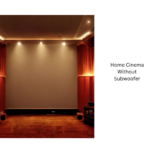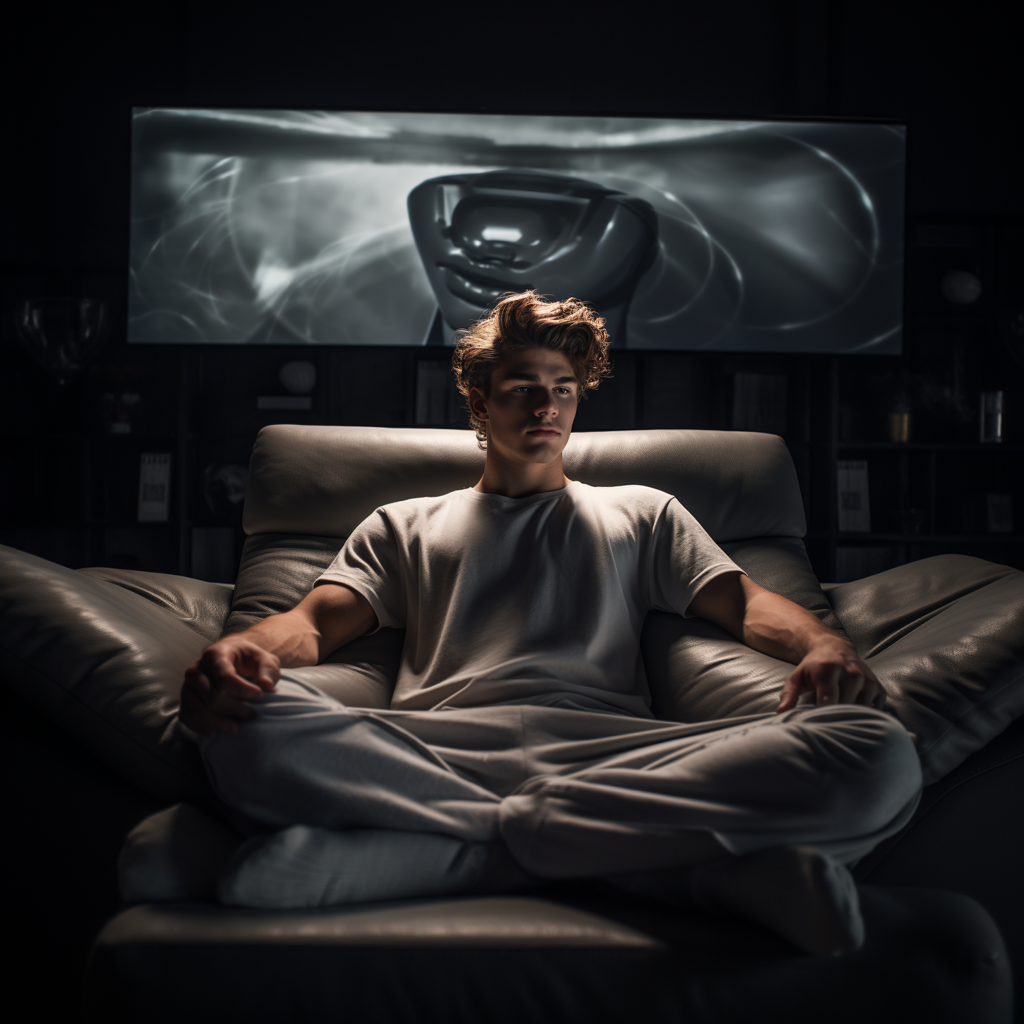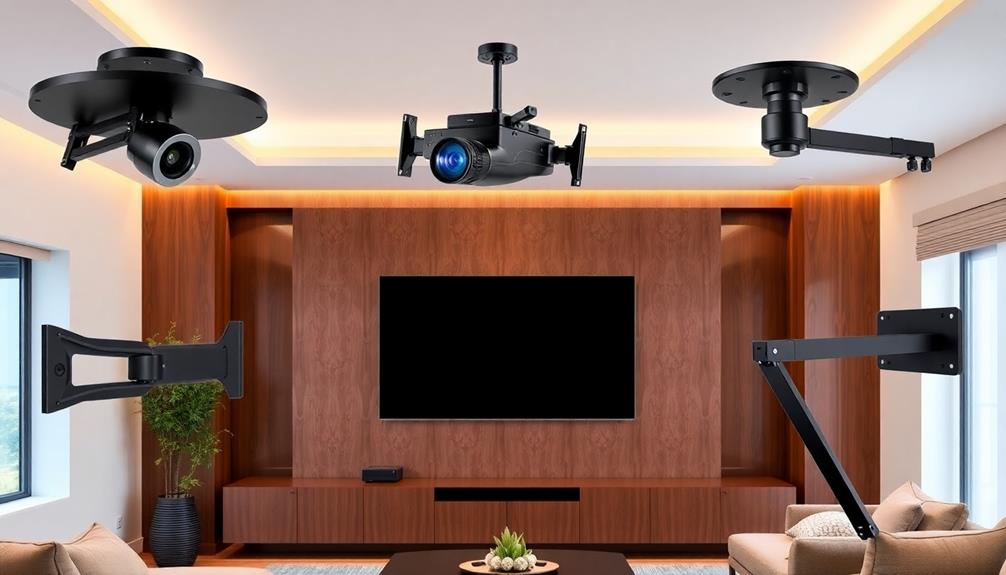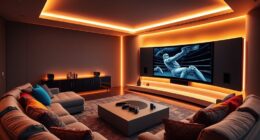You're about to transform your space into the ultimate home cinema. Start by defining your goals—do you want a cozy movie night hub or a high-tech gaming paradise? Select the right room with ideal dimensions and lighting, ensuring excellent acoustics. Invest in quality equipment like a 4K projector and a surround sound system for immersion. Arrange seats for comfort, focusing on viewing angles. Don't forget to budget for essential components and installation options. With these steps, you'll be well on your way, and there's even more to explore for crafting your perfect cinematic experience.
Key Takeaways
- Define your home cinema goals by identifying the primary purpose, desired audiovisual quality, and user capacity to guide your planning.
- Choose the right space with optimal dimensions, considering room shape and ambient lighting to enhance acoustics and viewing experience.
- Invest in essential audio and visual equipment, focusing on high-quality projectors, sound systems, and comfortable seating arrangements.
- Prioritize sound isolation and acoustic treatments to minimize external noise and improve sound quality within the cinema.
Defining Your Home Cinema Goals
To create your dream home cinema, you need to start by clearly defining its primary purpose, whether it's for watching movies, gaming, or enjoying sports. This decision will greatly influence your home theater system choices and overall room layout.
Think about the audiovisual quality you want; for instance, do you prefer a 4K projector or a high-end sound system like Dolby Atmos? Additionally, consider enhancing your audio experience with the best headphone amplifiers of 2024, which can elevate your sound quality greatly.
Next, consider how many people will usually be using the space. This helps you choose seating arrangements that guarantee everyone enjoys ideal viewing angles. If you're designing your home around a larger audience, you might want tiered seating or a larger screen.
Don't forget to set a budget that aligns with your goals. Your budget will guide you in selecting equipment and features, from soundproofing to smart home integration.
Selecting the Right Space

When you're selecting the right space for your home cinema, start by evaluating room dimensions to guarantee you'll have enough space for ideal viewing.
Think about how you'll use the room and consider the ambient lighting options to create that perfect cinematic atmosphere.
These factors will set the foundation for an enjoyable movie experience.
Assess Room Dimensions
Evaluating room dimensions is essential for creating a home theater that delivers exceptional viewing and sound quality. The right room size can enhance your overall experience, so aim for a minimum of 15 feet wide by 20 feet long, with a ceiling height of at least 7 feet. Remember, the room's shape also plays a significant role in acoustics; avoid cubic layouts to minimize sound distortion.
Here's a quick reference table to help you understand the ideal proportions for your home theater:
| Dimension Type | Recommended Ratio |
|---|---|
| Width to Ceiling Height | At least 1.6 times |
| Length to Ceiling Height | At least 2.3 times |
| Minimum Width | 15 feet |
| Minimum Length | 20 feet |
Accurate room dimensions help you determine ideal theater seating arrangements and guarantee the best viewing angles. Additionally, think about the placement of electrical outlets and wiring, as these will facilitate the seamless integration of audio and visual equipment while building a home theater. Make these considerations, and you'll set the foundation for an outstanding cinematic experience.
Consider Usage Requirements
Understanding how you'll use your home cinema space shapes everything from equipment choices to seating arrangements. Assess your primary usage requirements—whether you're hosting family movie nights, gaming sessions, or sports events. This decision influences your device selection and room layout greatly.
- Consider the number of viewers: More guests may require a larger screen size and different seating configurations.
- Choose between using an existing room or building a dedicated space: A dedicated home theater allows for better customization of acoustics and aesthetics.
- Evaluate your room dimensions and shape: Standard rectangular spaces work best, while cubic layouts can negatively impact sound quality.
Evaluate Ambient Lighting Options
Ambient lighting greatly impacts your home cinema experience, so selecting the right options is essential for creating an immersive viewing environment. To achieve this, consider using dimmable LED lights that offer adjustable brightness levels. These lights help reduce glare on your projector screen, enhancing the cinematic feel.
Incorporating blackout curtains or shades is another smart move. They effectively minimize external light interference, ensuring your projector delivers sharp, vibrant images. You'll appreciate the difference when watching your favorite films or shows without distractions from outside light.
Utilizing wall sconces or recessed lighting can also create a soft glow that highlights your room's design without detracting from the screen. When placing lighting fixtures, think about your seating arrangement and the screen's location. You want to avoid direct light exposure, maintaining a perfect balance between visibility and ambiance.
Essential Equipment Overview

When setting up your dream home cinema, you'll want to focus on key audio components, visual display options, and comfortable seating choices.
Each element plays an essential role in creating an immersive experience that keeps you engaged.
Let's explore how to choose the best equipment to elevate your movie nights.
Key Audio Components
To create a fascinating home theater experience, you'll need to focus on selecting the right audio components that work together seamlessly. Start with a high-quality home theater receiver, which acts as the central hub for managing audio and video. It processes sound and amplifies it to your speakers, providing an immersive experience.
For the best surround sound, aim for a minimum of five speakers: left, center, right, and two surround, along with a subwoofer. Here are some key considerations:
- Speaker Placement: Position speakers at ear level when seated for balanced sound distribution.
- Speaker Type: Choose between bookshelf, floor-standing, or in-wall speakers based on your room size and acoustics.
- Room Acoustics: Consider the acoustics of your room to enhance the overall audio experience.
Visual Display Options
Choosing the right visual display options is essential for elevating your home cinema experience, ensuring that every movie night feels like a trip to the theater.
Start by selecting high-quality projectors. The latest 8K ultra-high-definition projectors deliver stunning visuals that closely rival commercial cinema quality, making them a fantastic investment for movie enthusiasts.
Next, consider your projector screen. The size should be determined by your wall dimensions to maximize the viewing experience. Opt for an acoustically transparent screen if you plan to place speakers behind it; this choice allows sound to pass through without distortion, enhancing your audio experience.
Also, think about the aspect ratio of your screen. For most modern films, a 16:9 ratio works well, while cinematic releases often use a 2.35:1 ratio. This choice can affect how your content appears, so choose wisely.
Comfortable Seating Choices
After setting up your visual displays, the next step is selecting comfortable seating that enhances your movie-watching experience. Comfortable seating plays an essential role in your home cinema, ensuring you and your guests enjoy every moment without discomfort. Here are some options to take into account:
- Recliners: Perfect for relaxation, with features like adjustable headrests and lumbar support.
- Sofas: Great for a cozy feel, allowing you to snuggle up with loved ones.
- Dedicated theater seats: Designed for optimal support and viewing angles, making them ideal for serious movie buffs.
When choosing your seating, remember the ideal distance from the screen should be 1.5 to 2.5 times its size. High-quality options often feature memory foam padding to keep you comfortable during those long movie marathons.
Plus, don't forget to personalize your seating with fabric and color choices that match your home theater's design. With the right comfortable seating, your viewing experience will be elevated, making your home cinema the ultimate entertainment destination.
Designing for Acoustics and Comfort

Designing your home cinema with a focus on acoustics and comfort guarantees an immersive viewing experience that captivates the senses. Start by considering room dimensions; aim for a space at least 15 feet wide and 20 feet long with a ceiling height of 7 feet or more. This allows sound to travel and reflect properly.
Next, prioritize speaker placement. Keeping speakers at ear level when seated guarantees the sound envelops you, enhancing the overall experience. Use absorptive panels, diffusers, and bass traps to improve acoustics, minimizing sound reflections that can muddy your audio.
To further elevate comfort, design custom seating arrangements that prioritize ideal viewing angles. The "Kings Chair" should be the focal point, providing the best experience for the primary viewer.
Lastly, incorporate sound isolation techniques, like resilient channels and mass-loaded vinyl, to keep external noise at bay. This combination of design elements will create a cinema environment that invites you to lose yourself in every thrilling moment.
| Design Element | Purpose |
|---|---|
| Room Dimensions | Maximize sound and comfort |
| Speaker Placement | Guarantee immersive audio |
| Absorptive Panels | Minimize sound reflections |
| Custom Seating | Enhance viewing angles |
| Sound Isolation | Reduce external noise |
Budgeting for Your Project
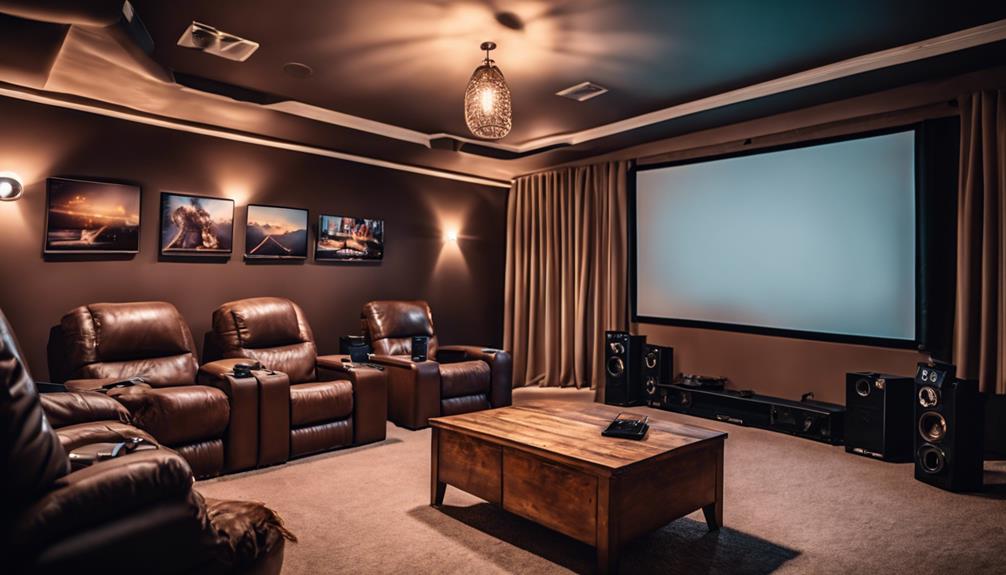
Establishing a clear budget for your home cinema project guarantees you make informed decisions on equipment and design without overspending. Aim for a budget range of $5,000 to $30,000 to guide your home theater planning effectively. Your budget will play a significant role in your design choices, influencing everything from audio-visual products to seating arrangements.
To help you stay on track, reflect on these budgeting tips:
- Prioritize essential components like projectors, screens, and sound systems.
- Allocate extra funds for installation and acoustic treatments.
- Regularly revisit your budget as you finalize your equipment selections.
A well-defined budget helps you balance quality and affordability, ensuring you get the most out of your investment. As you explore various options, remember to contemplate how each choice aligns with your overall budget.
Installation Options and Tips

When you're ready to set up your dream home cinema, you'll need to choose between a DIY installation for cost efficiency or hiring a professional AV installer for optimal results.
A professional can guarantee all your equipment—like projectors, screens, and speakers—are compatible and integrated correctly, avoiding performance issues.
If you opt for a DIY approach, plan your installation options carefully.
Start with cable management; hiding cables within walls or using cable conduits keeps your space clean and organized.
Don't overlook the room's acoustics. Using soundproofing materials and strategically placing acoustic panels can greatly enhance audio performance, making your viewing experience immersive.
Enhancing Your Viewing Experience

To truly elevate your home cinema experience, focus on high-quality visuals and immersive audio that bring movies to life. Start by selecting a high-quality projector with at least 4K resolution. This enhances image clarity and detail, making your viewing experience feel like a commercial cinema. Pair it with an A/V receiver that supports Dolby Atmos for a surround sound system that envelops you in three-dimensional audio.
Consider these key enhancements:
- Acoustic treatments: Add sound-absorbing panels and bass traps to minimize echoes and improve clarity in your home theater.
- Speaker positioning: Place speakers at ear level and use a 5.1 or 7.1 surround sound configuration for ideal sound distribution.
- Ambient lighting: Implement dimmable LED strips or sconces to create a cinematic atmosphere, enhancing focus on the screen while reducing glare.
Frequently Asked Questions
How Do You Make a Perfect Home Cinema?
To make a perfect home cinema, start by setting a clear budget. Measure your room, choose high-quality equipment, prioritize soundproofing, and consider smart technology for effortless control of your viewing environment. Enjoy the experience!
How Do I Make My House Feel Like a Cinema?
To transform your home into a cinematic oasis, embrace soundproofing magic, select a grand screen, and arrange seating like royalty. Dimmable lights and a surround sound symphony will elevate your movie nights into unforgettable experiences.
What Do I Need to Set up a Home Theater System?
To set up a home theater system, you'll need a projector or TV, an A/V receiver, five speakers plus a subwoofer, quality HDMI cables, and consider room dimensions and seating for the best experience.
What Size Room for 5.1 Surround Sound?
For a 5.1 surround sound setup, you'll need a room at least 12 feet by 15 feet. Confirm proper speaker placement, maintain ceiling height, and optimize dimensions for the best audio experience.
Conclusion
Creating your dream home cinema can transform your entertainment experience, making movie nights unforgettable.
Did you know that 80% of homeowners who invest in a home theater report increased enjoyment of their favorite films?
By following the steps outlined in this guide, from defining your goals to enhancing your viewing experience, you'll be well on your way to crafting a space that's not just a theater, but a personal retreat for relaxation and fun.
Start planning today!
Tom is the Editor-in-Chief of 1home Theatre Projector, a website that provides news and reviews on the best home cinema experiences. With over 10 years of experience in the industry, Tom knows what makes a great home theatre projector and wants to make it easy for everyone to build the perfect setup for their needs. When he’s not busy writing or testing projectors, Tom enjoys watching classic films and spending time with his family.




